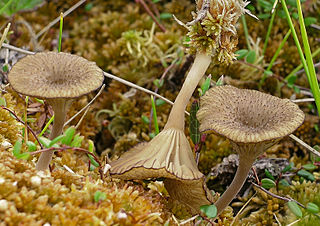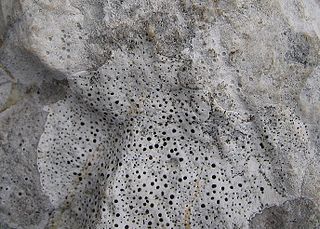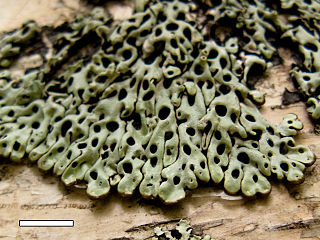
The Chlorophyceae are one of the classes of green algae, distinguished mainly on the basis of ultrastructural morphology. They are usually green due to the dominance of pigments chlorophyll a and chlorophyll b. The chloroplast may be discoid, plate-like, reticulate, cup-shaped, spiral- or ribbon-shaped in different species. Most of the members have one or more storage bodies called pyrenoids located in the chloroplast. Pyrenoids contain protein besides starch. Some green algae may store food in the form of oil droplets. They usually have a cell wall made up of an inner layer of cellulose and outer layer of pectose.

The spore print is the powdery deposit obtained by allowing spores of a fungal fruit body to fall onto a surface underneath. It is an important diagnostic character in most handbooks for identifying mushrooms. It shows the colour of the mushroom spores if viewed en masse.

The Psathyrellaceae are a family of dark-spored agarics that generally have rather soft, fragile fruiting bodies, and are characterized by black, dark brown, rarely reddish, or even pastel-colored spore prints. About 50% of species produce fruiting bodies that dissolve into ink-like ooze when the spores are mature via autodigestion. Prior to phylogenetic research based upon DNA comparisons, most of the species that autodigested were classified as Coprinaceae, which contained all of the inky-cap mushrooms. However, the type species of Coprinus, Coprinus comatus, and a few other species, were found to be more closely related to Agaricaceae. The former genus Coprinus was split between two families, and the name "Coprinaceae" became a synonym of Agaricaceae in its 21st-century phylogenetic redefinition. Note that in the 19th and early 20th centuries the family name Agaricaceae had far broader application, while in the late 20th century it had a narrower application. The family name Psathyrellaceae is based on the former Coprinaceae subfamily name Psathyrelloideae. The type genus Psathyrella consists of species that produce fruiting bodies which do not liquify via autodigestion. Psathyrella remained a polyphyletic genus until it was split into several genera including 3 new ones in 2015. Lacrymaria is another genus that does not autodigest its fruiting bodies. It is characterized by rough basidiospores and lamellar edges that exude beads of clear liquid when in prime condition, hence the Latin reference, lacryma (tears).

The Hygrophoraceae are a family of fungi in the order Agaricales. Originally conceived as containing white-spored, thick-gilled agarics, including Hygrophorus and Hygrocybe species, DNA evidence has extended the limits of the family, so it now contains not only agarics, but also basidiolichens and corticioid fungi. Species are thus diverse and are variously ectomycorrhizal, lichenized, associated with mosses, or saprotrophic. The family contains 34 genera and over 1000 species. None is of any great economic importance, though fruit bodies of some Hygrocybe and Hygrophorus species are considered edible and may be collected for sale in local markets.

Omphalina is a genus of small agarics with white, nonamyloid, basidiospores and decurrent gills. Typically the cap has a deep central depression giving the umbrella-like to funnel-shaped cap the appearance of a belly button, or a belly with a navel. Similarly-shaped agarics are said to be omphalinoid in appearance.

The Pilobolaceae are a family of fungi in the Mucorales order. Generally, species in this family have a widespread distribution, although there are some that are restricted to tropical and subtropical regions. This family includes two genera: Pilobolus, and Utharomyces.

Mythicomyces is a fungal genus in the family Mythicomycetaceae. A monotypic genus, it contains the single species Mythicomyces corneipes, first described by Elias Fries in 1861. The fungus produces fruit bodies with shiny yellowish-orange to tawny caps that are 1–3 cm (0.4–1.2 in) in diameter. These are supported by stems measuring 2–5.7 cm (0.8–2.2 in) long and 1–2 mm thick. A rare to uncommon species, it is found in northern temperate regions of North America and Europe, where it typically fruits in groups, in wet areas of coniferous forests. There are several species with which M. corneipes might be confused due to a comparable appearance or similar range and habitat, but microscopic characteristics can be used to reliably distinguish between them.

The Physciaceae are a family of mostly lichen-forming fungi belonging to the class Lecanoromycetes in the division Ascomycota. A 2016 estimate placed 19 genera and 601 species in the family.

Verrucariales is an order of ascomycetous fungi within the subclass Chaetothyriomycetidae of the class Eurotiomycetes. Although most of the Verrucariales are lichenised, the family Sarcopyreniaceae consists of 11 species of lichenicolous (lichen-dwelling) fungi.

Porina is a genus of crustose lichens in the family Porinaceae. As of August 2024, Species Fungorum accepts 161 species of Porina.

Phaeophyscia is a genus of lichen-forming fungi in the family Physciaceae.

Menegazzia is a genus of lichenized fungi containing roughly 70 accepted species. The group is sometimes referred to as the tree flutes, honeycombed lichens, or hole-punch lichens. The most obvious morphological feature of the genus is the distinctive perforations spread across the upper side of the thallus. This makes the group easy to recognise, even for those not particularly familiar with lichen identification.

Mycena nidificata is a species of fungus in the family Mycenaceae of the Agaricales. First collected in 2000 and reported as a new species in 2007, it is known only from Kanagawa, Japan, where it grows on the floor of oak forests. The dark brown irregularly wrinkled cap measures up to 25 mm (1.0 in) in diameter. The cap is supported by a thin stem up to 50 mm (2.0 in) long, which is covered at the base by a whitish hairlike growth, and attached to white, cord-like rhizomorphs—aggregations of mycelium that resemble plant roots. The underside of the cap features thin, distantly spaced grayish gills that have distinct veins running between them. At a microscopic level, distinguishing characteristics include the inamyloid spores, the club-shaped cheilocystidia with finger-like appendages, the diverticulate cells in the outer layer of cap and stem, and the presence of clamp connections.
Clitopilus byssisedoides is a species of fungus in the family Entolomataceae. It was formally described as new to science in 2010, based on specimens found growing in a greenhouse in Botanischer Garten Jena, in Germany.
Stagnicola is an agaric fungal genus that contains the single species Stagnicola perplexa. This fungus colonizes plant debris in wet coniferous forest floor depressions and shallow pools, and fruits after the pools drain or dry in late summer to early fall in North America and Europe. The genus is characterized by smooth, yellowish brown basidiospores lacking a germ pore, and a naucorioid appearance, with brownish mycelium at the base of the stems. Phylogenetically, Stagnicola appeared rather isolated and proved to be closest to Mythicomyces and Mythicomyces was closest to the Psathyrellaceae. In 2019 the two genera were shown to be closely related and placed in a new family, Mythicomycetaceae sister to the Psathyrellaceae.
Romagnesiella is an agaric fungal genus that colonizes mineral, calcareous or sandy soils in Europe and North Africa. The small brownish fruitbodies have narrowly attached, broad and distant lamellae and poorly differentiated cheilocystidia and pleurocystidia. Spores are thick-walled, brown, smooth, and lack germ pore. The cap surface (pileipellis) is somewhat cellular with irregular puzzle-like to pyriform hyphae. Clamp connections are present in the hyphae. It is most closely related to Crassisporium, both genera being close to the Strophariaceae or the Cortinariaceae.

The Crassisporiaceae is a mushroom family of small brown, naucoroid, brown-spored agarics with thick to slightly thickened, smooth, basidiospore walls that darken to reddish brown in potassium hydroxide (KOH) solution, absence of chrysocystidia, presence of cheilocystidia, nongelatinized tissues in the lamellae, and a filamentous pileus cutis. The family is recognized based upon phylogenetic analyses using DNA sequences and depending upon the analyses varies in relationship to either the Cortinariaceae or, as described in greater detail prior to recognition as a separate family, near the Strophariaceae. Crassisporium is pyrophilous and Romagnesiella may be bryophilous.

The Tephromelataceae are a family of lichenized fungi in the order Lecanorales. The family was circumscribed by Austrian lichenologist Josef Hafellner in 1984. Tephromelataceae comprises the genera Tephromela, Calvitimela, Mycoblastus and Violella, which together constitute a well-supported monophyletic group.
Malmographina is a fungal genus in the family Graphidaceae. The genus is monotypic, containing the single species Malmographina plicosa, a script lichen found in South America. Genus Malmographina is characterised by its smooth, olive-green thallus, erumpent to prominent lirellae with orange to cinnabar-red pigment, a clear hymenium, and hyaline, non-amyloid ascospores.















